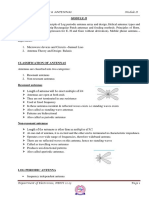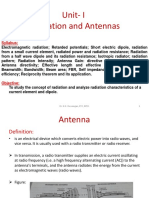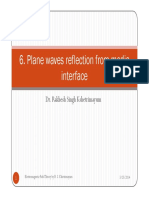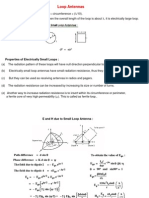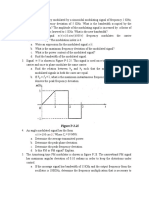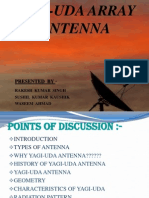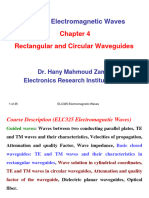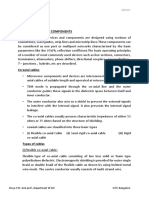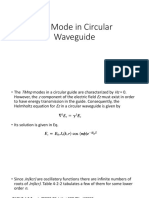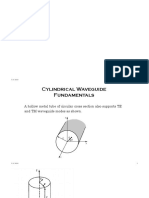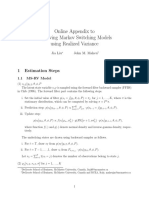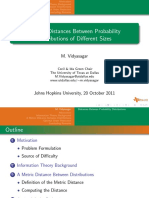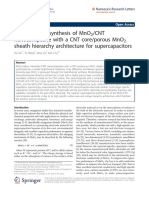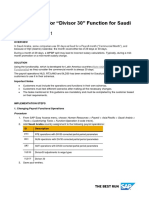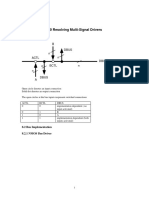Rectangular Waveguides
Can operate from 1 GHz to 220 GHz.
TE Modes
-z
usually a>b
b
TE modes means Ez=0 &
Hz 0
The eqn we have to solve is:
2
2 + 2 + kc2 hz ( x, y) = 0
x y
Recall :
H z = hz e jz
(k
2
c
= k2 2
(31)
To solve eqn (31) we can use the method of separation of variables:
Let
hz ( x, y) = X ( x)Y ( y)
2
2
2 + 2 + kc2 X ( x)Y ( y ) = 0
x y
(32)
or
�2 X
2Y
Y + 2 X + kc2 XY = 0
2
x
y
(33)
By dividing by XY on both sides we get:
1 2 X 1 2Y
+
+ kc2 = 0
2
2
X x
Y y
(34)
To solve the above equation we set:
2
kc2 = k x + k y
We divide equation (34) into two equations:
2 X
+ k x2 X = 0
2
x
2Y
+ k y2Y = 0
2
y
With solutions:
X ( x) = A cos k x x + B sin k x x
(35)
Y ( y ) = C cos k y y + D sin k y y
(36)
hz ( x , y ) = X ( x)Y ( y ) =
= ( A cos k x x + B sin k x x )(C cos k y y + D sin k y y ) (37)
�To find the constants we apply the boundary conditions at y=0,
y=b and x=0, x=a planes. The tangential e field has to be zero
i.e.
ex (x, y) = 0 & ey (x, y) = 0
at these planes.
Using Maxwells eqns we can solve for ex & ey (using hz)
ex =
j
k y ( A cos k x x + B sin k x x )( C cos k y y + D sin k y y )
kc2
&
ey =
j
k x ( A cos k x x + B sin k x x )(C cos k y y + D sin k y y )
kc2
By applying the B. C.s we can show that:
np
C = 0 ky =
for n = 0,1,2...
b
mp
B = 0 kx =
for m = 0,1,2...
a
and
Which yields:
H z ( x, y , z ) = !
AC cos
Amn
mx
ny jz
cos
e
a
a
(38)
Once we have Hz we can solve for the transverse components of
Ex , Ey , Hx, Hy .
Ex =
jn
mx
ny jz
Amn cos
sin
e
2
kc b
a
b
Ey =
jm
mx
ny jz
A
sin
cos
e
mn
k c2 a
a
b
Hx =
jbm
mx
ny jz
A
sin
cos
e
mn
k c2 a
a
b
Hy =
jbn
mx
ny jz
Amn cos
sin
e
2
kc b
a
b
� = propagation cons tan t = k 2 kc2 or
2
m n
= k
a b
m n
kc =
+
= cutoff wavenumbers depends on a & b
a b
f Cmn = cutoff frequency =
The wavelength
given by:
kc
vp
f
vg =
m n
a b
inside the waveguide for the Temn modes is
g =
Where:
f
1 c
f
is the wavelength in the unbounded medium
=
g
vp
f
1 c
f
velocity inside the
waveguide
The actual velocity of energy in a lossless guide is given by the
group velocity
2
v group =
c
vp
The propagation constant inside is also:
f
g = 1 c
f
rad / m
�The characteristic wave impedance is:
ZTE =
/
f
1 c
f
n & m cannot both be zero.
There is no TE00 mode.
The first (dominant) mode that can occur is the m=1, n=0 mode
x jz
or TE10
H z= A10 cos
E y=
Hx =
ja
j a
A10 sin
A10 sin
x
a
x
a
e j z
e j z
Ex = Ez = H y = 0
-z
Electric field lines are shown solid and magnetic field lines are dashed
�Usually waveguides are designed to let one mode (dominant
mode) propagate only so that signal distortion caused by
multimode propagation can be avoided.
When the frequency is high enough to permit transmission in
move than one mode, the resultant field is the sum of the fields of
the individual mode fields in the guide.
Example:
Higher order modes in
Rectangular waveguides
�Example: Rectangular waveguide
b = 2 cm
r = 2.56
a = 5 cm
�Rectangular waveguide
cutoff freqs. of model for f = 0..6GHz
1.87 GHz
3.75 GHz
4.68 GHz
5.04 GHz
5.99 GHz
TE(z,10)
TE(z,20)
TE(z,01)
TM(z,11)
TM(z,21)
TE(x,10)
TE(x,20)
TM(x,01)
TE(x,11)
TM(x,21)
TM(y,10)
TM(y,20)
TE(y,01)
TM(x,11)
TE(y,21)
TE(y,11)
degenerate modes !
TM(y,11)
Modes at 1.87 GHz
1.87 GHz
TE(z,10)
E-field
TE(x,10)
TM(y,10)
H-field
�Modes at 3.75 GHz
3.75 GHz
TE(z,20)
E-field
TE(x,20)
TM(y,20)
H-field
Modes at 4.68 GHz
4.68 GHz
E-field
TE(z,01)
TM(x,01)
TE(y,01)
H-field
10
�Modes at 5.04 GHz
5.04 GHz
5.04 GHz
TM(z,11)
TM(x,11)
TM(y,11)
TE(y,11)
TE(x,11)
E-field
H-field
How to read fc by S2,1 parameters
compare with fcs stated earlier
11
�Evanescent mode
Propagating mode
recorded at 1.5 GHz
recorded at 2 GHz
12
�Losses
There are two types : 1) due to the dielectric
2) due to the metallic guide walls
ad =
!
The E &
f
2 1 c
f
Np /m
dielectric attenuatio n
Wall losses
!
H fields decay at the walls exponentially with
respect to the skin depth .
We define a surface resistance Rs :
Rs =
resistivity of the walls
=
skin depth
Rs =
Power loss per unit length of the guide is:
PL =
Rs
2
2
t
dl
c = perimeter of wall
13
�TEmn parameters
kc
TMmn parameters
2
m
m
+
= c , a and b in
a
b
m
m
+
= c
a
b
meters
fc
m2 n2
+
a 2 b2
1
2
vg
Zg
=
g
vp
f
1 c
f
m2 n2
+
a 2 b2
1 c
f
1 c
f
vp =
Ex
E
= x =
=
Hy
H y g
f
1 c
f
=
g
vp
f
1 c
f
g
f
= 1 c
f
1 c
f
1
2
fc
, =
f
' 1
f
1 c
f
'
f
1 c
f
How do we excite these modes???
14
�Circular Waveguides
A circular waveguide is a tubular circular conductor and the
solution of field equations are given for sinusoidal steady state
frequency domain solutions. Bessel functions are used in solving
for the fields.
z
r
a
TE modes
Ez = 0
E =
j n
( A cos(n ) B sin( n ) ) J n (kc )e j z
2
kc
E =
j
( A sin( n ) + B cos(n ) )J n' (kc )e j z
kc
H z = ( A sin( n ) + B cos( n ) )J n (kc )e j z
H =
j
( A sin( n ) + B cos(n ) )J n' (kc )e j z
kc
H =
j n
( A cos(n ) B sin( n ) )J n (kc )e j z
2
kc
15
�TM modes
E z = ( A sin( n ) + B cos( n ) )J n (kc )e j z
E =
j
( A sin( n ) + B cos(n ) )J n' (kc )e j z
kc
E =
j n
( A cos(n ) B sin( n ) )J n (kc )e j z
2
kc
Hz = 0
H =
jn
( A cos( n ) B sin( n ) ) J n (kc )e j z
2
kc
H =
j
( A sin( n ) + B cos(n ) )J n' (kc )e j z
kc
kc =
Where
x'
'
X np
represents the roots of the Bessel function
( that are used to satisfy the boundary conditions)
f
1 c
f
Ptr =
2
2
2
( E + E )rdrd
for TEnp mod e
16
�Power transmission in circular
waveguide
f
1 c
f
Ptr =
2
Ptr =
2
2
1
f
2 1 c
f
1
Ptr = V0 I 0
2
( E + E )rdrd
2
for TEnp mod e
( E + E )rdrd
for TM mp
for TEM mod e
Circular waveguide parameters
Circular waveguide
TE mode
kc
TM mode
'
np
'
X np
= c
a
X
= c
a
X'
2 np
a
fc
'
X np
=
g
2a
vp
f
1 c
f
=
g
=
g
vp
f
1 c
f
f
1 c
f
Zg
'
X np
2a
vg
X'
2 np
a
f
1 c
f
f
1 c
f
g
f
= 1 c
The dominant mode or the lowest cutoff frequency in a circular waveguide is the mode of
TE11.
17
�Example: Circular Waveguide
er = 2.56
a = 1 cm (radius)
Dominant TE1,1 mode at 5.49 GHz
E-field
H-field
18
�Dominant TM0,1 mode at 7.17 GHz
E-field
H-field
TE mode at 9.05 GHz
E-field
determine which TE
mode this is
H-field
19
�TE mode at 9.07 GHz
E-field
determine which TE
mode this is
H-field
20
















